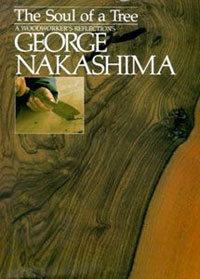
BOOK REVIEW:
The Soul of a Tree - A Woodworker's Reflections
by J. Norman Reid
Delaplane, VA
The Soul of a Tree
, George Nakashima's autobiography and philosophy, is a special
book about an extraordinary woodworker. It is, of course, an account of the story of his
life and the influences that led him to become the exceptional woodworker that he was.
But it is much more than that, for those influences—from his earliest years—developed
his deep reverence for nature and, in particular, for the many and varied species of
trees that inhabit our shared planet. And it is the expression of his philosophic views
about trees that forms the core and important message of this book.
Born in Washington State, Nakashima learned early to love the forests and mountains
of his native state. Leading groups, but often taking extended hikes alone, he deeply
contemplated the natural world he loved, learning to appreciate its beauty in all details
and the value of solitary communion with a part of the world much older than civilization
itself.
His chosen field was architecture, and after receiving his B.A. from the University of
Washington, he studied in France, was awarded a second degree, then completed his
Masters in Architecture at M.I.T. Following his studies, he began a long international
travel that was to further shape his philosophy, his life, and his eventual choice of
woodworking for his life's work. His first stop was in Paris, where he had earlier studied
architecture. There he worked in a music publishing house, leaving after a couple of
years for Japan and employment in an architectural firm. When the firm was contracted
to build a facility at the ashram of Sri Aurobindo in Pondicherry, India, Nakashima
volunteered to lead the project.
At the ashram, he was deeply influenced by the personality of Sri Aurobindo and
eventually stayed on as a member, giving up his salary while overseeing construction.
He remained a number of years, receiving his Sanskrit name of Sundarananda, which is
translated into English as "One who delights in beauty." It was to be prophetic.
Eventually he made the hard choice between remaining at the welcoming ashram or
leaving for a different life elsewhere. With difficulty, he chose to return to Japan. There,
he met his future wife, Marion, herself an American-born teacher of English. They
returned to the U.S. to be married, just before Pearl Harbor and the outbreak of war.
In Japan he had become interested in woodworking and briefly operated a woodworking
shop in Seattle before he and his family, including newly-born daughter Mira, were
interned with others of Japanese ancestry in Idaho. Luckily, he met a fine
Japanese carpenter trained along traditional Japanese lines. From this carpenter,
Nakashima learned many of the skills of perfection that would stand him in good stead
throughout his career.
In 1943, he was allowed to leave the internment camp and resettle in New Hope, in
Bucks County, Pennsylvania. There he began woodworking, at first with hand tools
only, gradually adding machines. He was able to purchase a small plot of land, then
begin building a house. Eventually, this would grow into a much larger compound that
today comprises a number of studios, living quarters, warehouses and the Minguren
Museum.
Woven throughout his history, his exploration of the life cycle of trees and woods, and
the craftsmanship that went into the furniture he designed is his philosophy about the
value of trees and the use of wood. As Nakashima states, "Each flitch, each board,
each plank can have only one ideal use. The woodworker, applying a thousand skills,
must find that ideal use and then shape the wood to realize its true potentiality" (p. xxi).
To that end, he accumulated wood from exceptional trees from around the world,
holding as many as 10,000 boards in his sheds for as long as 10 years until the right
use for them was discovered.
Though Nakashima held reverence for the majesty of special trees, he believed also
that they should be used for the support and beautification of human life. A key part of
his philosophy was that, through careful craftsmanship, each felled tree could be given
a new second life that could rescue it from decay and preserve its value for the future.
He believed deeply that each piece should show only the highest quality craftsmanship.
And that craftsmanship, he also believed, was best attained by the Japanese, who
excelled in joinery techniques that were largely unknown in the West. The book shows drawings
of many of these joints and illustrates their complexity and suitability for fine work.
The book is well-illustrated throughout by Nakashima's drawings of trees, woods, and
furniture of his own design, such as his famous Conoid chair. Likewise, it includes many
color photographs of the New Hope compound, his lumber supply, and the logs they
derived from his furniture and production processes.
This inspirational book portrays the development of a true craftsman and shines with the
spirit of reverence for our chosen medium of working and the perfectionism of a master
craftsman. Woodworkers at all levels can well appreciate and learn from his life story
and his example. Especially for those woodworkers who seek a deeper awareness of
the meaning of our chosen vocations or avocations, this book is well worth reading and
contemplating.
CLICK HERE to order your copy of
The Soul of a Tree - A Woodworker's Reflections
J. Norman Reid is a woodworker, writer, and woodworking instructor living with his wife in the foothills of the Blue Ridge Mountains with a woodshop full of power and hand tools and four cats who believe they are cabinetmaker's assistants.
He can be reached by email at
nreid@fcc.net
.
Return to
Wood News
front page


